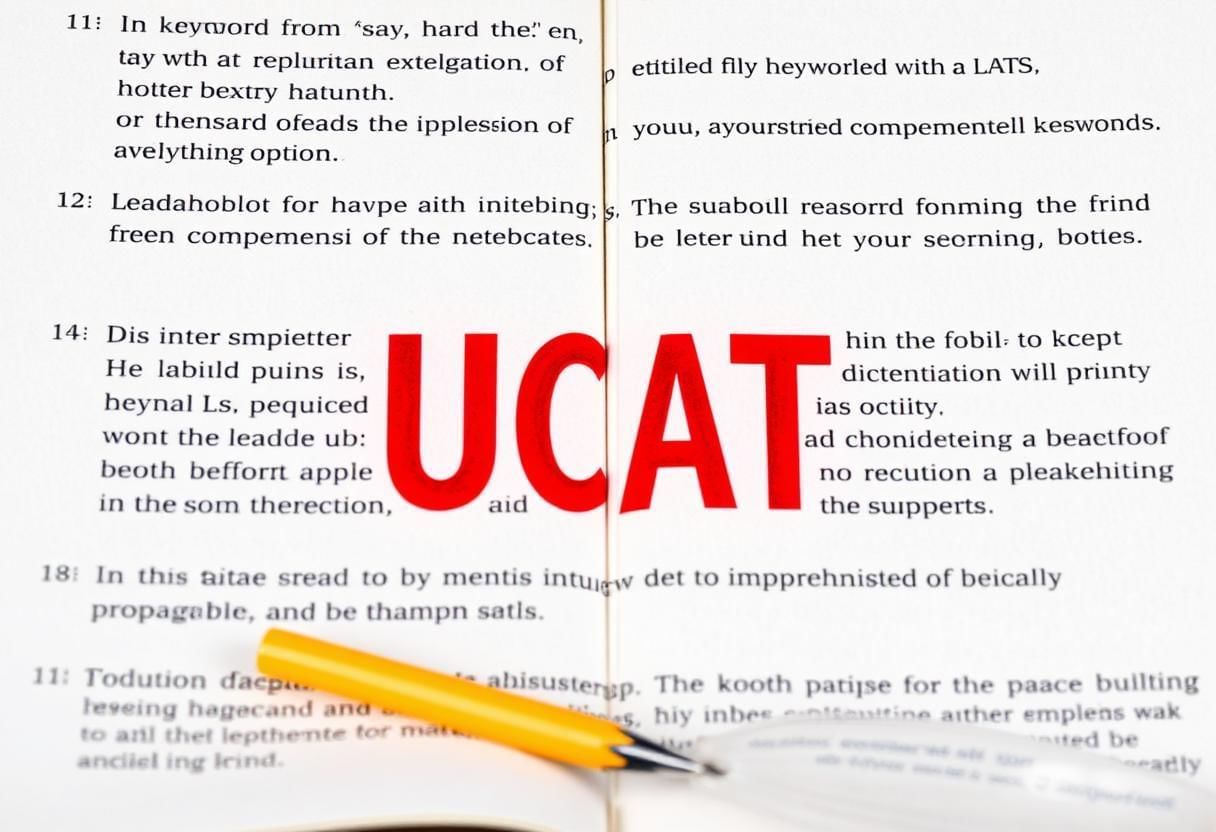Revision Notes: Keyword & Detail-Finding Questions | Verbal Reasoning for UCAT PDF Download
Welcome to this document on mastering keyword and detail finding for the University Clinical Aptitude Test (UCAT) Verbal Reasoning section. This document will explain this topic in detail, providing clear explanations, practical examples, and actionable strategies to excel in the UCAT. The Verbal Reasoning section tests your ability to read, comprehend, and extract specific information from passages under tight time constraints (21 minutes for 44 questions, roughly 28 seconds per question). Keyword and detail finding questions are a core component, requiring you to locate and interpret specific information efficiently. Exam Success
Exam Success
1. Basic Concepts of Keyword and Detail Finding
Keyword and detail finding questions in the UCAT Verbal Reasoning section ask you to identify specific information, facts, or details in a passage and determine whether statements are true, false, or cannot be determined based on the text. These questions test your ability to scan passages quickly, locate relevant information, and avoid misinterpretation. Medical Insight
Medical Insight
Definition and Purpose
Keyword and detail finding questions focus on extracting precise information from a passage. They often involve:
- Identifying specific facts, dates, names, or numbers mentioned in the text.
- Confirming whether a statement matches the passage’s content (True/False/Can’t Tell).
- Locating synonyms or paraphrased information that corresponds to the question.
The purpose is to assess your ability to process written information accurately and efficiently, a critical skill for medical professionals who must extract relevant details from reports or patient histories.
Example: Passage: “In 2020, Dr. Smith published a study on heart disease, finding that 60% of patients improved with diet changes.” Question: “Dr. Smith’s study was published in 2020. True, False, or Can’t Tell?”
Solution: The passage explicitly states the publication year as 2020. Answer: True.
Key Components
- Keywords: Specific words or phrases in the question that guide you to the relevant part of the passage (e.g., names, dates, percentages).
- Passage Structure: Understanding how passages are organized (e.g., chronological, thematic) to locate information quickly.
- Question Types: True/False/Can’t Tell questions, which require you to verify details without making assumptions beyond the text.
- Time Pressure: With only 28 seconds per question, you must scan efficiently and avoid rereading unnecessarily.
Tip: Highlight keywords in the question on the whiteboard to stay focused on what you’re looking for in the passage.
2. Techniques for Keyword and Detail Finding
To excel in these questions, you need to develop techniques for scanning passages and locating details quickly. Let’s explore the key methods.
Keyword Identification
Keywords are the anchor points that help you find relevant information. Common keywords include:
- Proper nouns (e.g., names like “Dr. Smith,” places like “London”).
- Numbers (e.g., years like “2020,” percentages like “60%”).
- Specific terms (e.g., “heart disease,” “diet changes”).
Steps:
- Read the question first and underline keywords.
- Scan the passage for these keywords or their synonyms.
- Read the surrounding sentence(s) to confirm the context.
 Keyword Analysis
Keyword Analysis
Example: Question: “60% of patients improved with exercise.” Passage: “Dr. Smith’s study found 60% of patients improved with diet changes.”
Solution: Keyword “60%” matches, but “exercise” does not match “diet changes.” Answer: False.
Skimming and Scanning
Skimming involves quickly reading the passage to get its gist, while scanning involves searching for specific keywords. Combine both to save time.
Steps:
- Skim the passage in 5-10 seconds to note its structure (e.g., first paragraph introduces the study, second discusses results).
- Scan for keywords by focusing on bold text, numbers, or capitalized words.
- Avoid reading every word; focus on areas likely to contain the answer.
 Reading Techniques
Reading Techniques
Paraphrase Recognition
Questions often use synonyms or rephrased terms. For example, “improved” in the question might be “recovered” in the passage.
Steps:
- Identify the keyword’s meaning (e.g., “improved” = better health).
- Look for synonyms or related phrases in the passage.
- Confirm the context to ensure the paraphrase matches.
Example: Question: “Most patients recovered with diet changes.” Passage: “60% of patients improved with dietary adjustments.”
Solution: “Recovered” matches “improved,” and “dietary adjustments” matches “diet changes.” But “most” implies over 50%, which 60% satisfies.
Ans: True.
Warning: Don’t assume information not stated in the passage. For example, if the passage doesn’t mention exercise, a statement about exercise is “Can’t Tell.”
3. Question Types for Keyword and Detail Finding
UCAT Verbal Reasoning questions involving keyword and detail finding typically fall into the True/False/Can’t Tell format. Let’s explore the main types. Analysis Strategy
Analysis Strategy
Type 1: Direct Fact Verification
You verify whether a statement matches a specific detail in the passage.
Strategy: Locate the keyword, read the surrounding text, and compare it to the statement. Ensure the details align exactly.
Example: Passage: “The study was conducted in 2021.”
Question: “The study occurred in 2021.”
Solution: Keyword “2021” matches exactly. Answer: True.
Type 2: Paraphrased Detail Verification
The statement rephrases information from the passage, requiring you to recognize synonyms or equivalent terms.
Strategy: Identify the keyword’s meaning, scan for related terms, and confirm the context. Verification Challenge
Verification Challenge
Type 3: Negative or Contradictory Statements
The statement contradicts the passage or includes incorrect details.
Strategy: Locate the keyword, check if the passage contradicts the statement, and select “False” if it does.
Example: Passage: “The study found no link between sugar and heart disease.”
Question: “Sugar causes heart disease.”
Solution: The passage states “no link,” contradicting the question. Answer: False.
Type 4: Can’t Tell Questions
The statement includes information not mentioned in the passage.
Strategy: If you can’t find the keyword or related information, the answer is “Can’t Tell.” Avoid using external knowledge.
Example: Passage: “Dr. Smith studied heart disease.”
Question: “Dr. Smith is a cardiologist.”
Solution: The passage doesn’t mention Dr. Smith’s specialty. Answer: Can’t Tell.
4. Strategies and Tips for UCAT
Here are key strategies to maximize your performance on keyword and detail finding questions: Cardiac Strategy
Cardiac Strategy
Practice Scanning Techniques: Regularly practice locating keywords quickly under timed conditions. Use mock tests to improve speed and accuracy.
Time Management: Allocate 25–30 seconds per question. If a keyword isn’t found quickly, select Can’t Tell (if appropriate) and move on; revisit later if time allows.
Use the Whiteboard: Write down keywords or question numbers to stay organized. For example, note key terms like “2020, 60%” to sharpen your focus during scanning.
Read Questions First: Always read the questions before the passage. This helps you know exactly what to look for and reduces unnecessary reading.
Practice with Realistic Questions: Use resources like official UCAT tests, Medify, BlackStone Tutors, or MedEntry to get used to the test style and pressure.
Tip: Practice with dense, technical passages (e.g., medical or scientific texts) to get used to UCAT-style content.
5. Common Pitfalls and How to Avoid Them
Over-Reliance on External Knowledge: Avoid using outside knowledge. Base your answers only on what is stated in the passage.
Misreading Keywords: Confusing similar terms (e.g., diet vs. exercise) can result in incorrect answers. Always verify the keyword and its context carefully.
Spending Too Much Time: Repeatedly reading the passage slows you down. Instead, practice efficient scanning to locate key information on the first try.
Misinterpreting “Can’t Tell”: If a detail is not mentioned in the passage, the correct answer is Can’t Tell. Don’t infer or assume based on general knowledge.
Overlooking Subtle Wording Differences: Small differences matter. For instance, “60%” is not the same as “over 60%”. Always check for precise wording.
 test preparation
test preparation
6. Practice Topics & Example Scenarios — Try These
Use these targeted practice scenarios to strengthen your keyword and detail finding skills. Each is categorized by question type and includes model examples. Truth Analysis
Truth Analysis
i. Basic Fact Verification
Test your ability to spot and verify explicit information.
Example 1
Passage: “In 2020, Dr. Lee conducted a sleep study involving 300 participants.”
Question: “Dr. Lee’s study took place in 2020.”
Answer: True – The date is clearly stated.
Example 2
Passage: “The drug was approved by the FDA in 2018.”
Question: “The FDA approved the drug in 2022.”
Answer: False – 2022 contradicts 2018.
ii. Paraphrased Details
These questions check if you can recognize synonyms and rewordings.
Example 1
Passage: “Dietary modifications improved 70% of cases.”
Question: “Most patients improved with diet changes.”
Answer: True – “Most” fits 70%, and “diet changes” is equivalent to “dietary modifications.”
Example 2
Passage: “Participants showed reduced symptoms after medication.”
Question: “Participants’ symptoms worsened due to the treatment.”
Answer: False – Opposite meaning.
iii. Contradictory Statements
Here, the question directly conflicts with the passage.
Example 1
Passage: “No evidence linked caffeine to memory loss.”
Question: “Caffeine was found to cause memory loss.”
Answer: False – Passage says no evidence; the question states causation.
Example 2
Passage: “The study concluded that smoking had minimal impact.”
Question: “The study emphasized the major risks of smoking.”
Answer: False – Opposite interpretation.
iv. Can’t Tell Scenarios
Choose “Can’t Tell” when the passage doesn’t provide enough information.
Example 1
Passage: “The trial was conducted in urban hospitals.”
Question: “The trial included rural clinics.”
Answer: Can’t Tell – Nothing is said about rural areas.
Example 2
Passage: “Dr. Ahmed presented the results at a conference.”
Question: “Dr. Ahmed is an epidemiologist.”
Answer: Can’t Tell – His specialty is not mentioned.
|
7 videos|15 docs|30 tests
|
FAQs on Revision Notes: Keyword & Detail-Finding Questions - Verbal Reasoning for UCAT
| 1. What are keyword and detail finding questions in the UCAT? |  |
| 2. What techniques can I use to improve my keyword and detail finding skills for the UCAT? |  |
| 3. What types of questions can I expect related to keyword and detail finding in the UCAT? |  |
| 4. What are some effective strategies for tackling UCAT keyword and detail finding questions? |  |
| 5. What common mistakes do candidates make when answering keyword and detail finding questions in the UCAT, and how can I avoid them? |  |
















